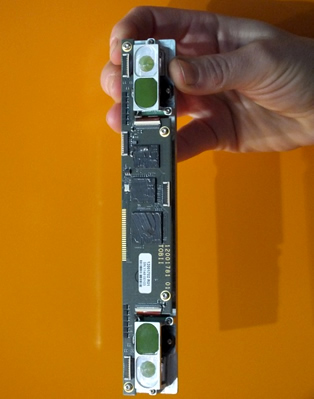At CeBIT yesterday, Tobii unveiled its IS-2, an improved version of the eye-tracking device shown at CES last year. The human interface device aims to give users the ability to control games and software merely by moving their eyes. Additionally, Tobii says it is working with 3D manufacturers to create a glasses-free 3D experience by incorporating its eye-tracking technology into 3D displays.
Tobii has been showing off their ability translate eye motion into user input for a few years now, but the device caught a considerable amount of attention at this year's CES. The company demonstrated their "Gaze" technology for navigating around a Windows 8 laptop with merely a pair of eyes and it looked surprisingly effective and accurate. The latest version is smaller and more responsive than ones used in previous demonstrations.
The IS-2 works by illuminating the user's pupils with small infrared projectors. Special cameras will then track the user's eyes, translating the motion into useful input which can be used to direct a connected PC.
By utilizing pupil positioning, Tobii hopes to leverage their eye-tracking expertise to improve 3D display technology. If a display can determine a user's distance, relative position and where they are looking, such a device could theoretically tailor a 3D image for that person by making simple visual adjustments – no glasses needed.
Before new users hop on to try the device, it must be calibrated first. On demonstration units, calibrating the IS-2 took about 10 seconds. Since every person has a unique set of eyes and user environments can vary a great deal, calibration is necessary in order to ensure accurate motion tracking.
It's worth noting that the IS-2 seems to do a pretty good job of determining your intent. The device will ignore aberrant input, such as looking away from the screen or at something else which catches your attention.
Interestingly, users seem to get a handle on the technology very quickly. ZDNet UK claims after using the device for less than a minute, you might even forget it is there. Unlike a mouse or other input peripherals, the method of input is almost entirely passive and requires no physical contact with the device.
